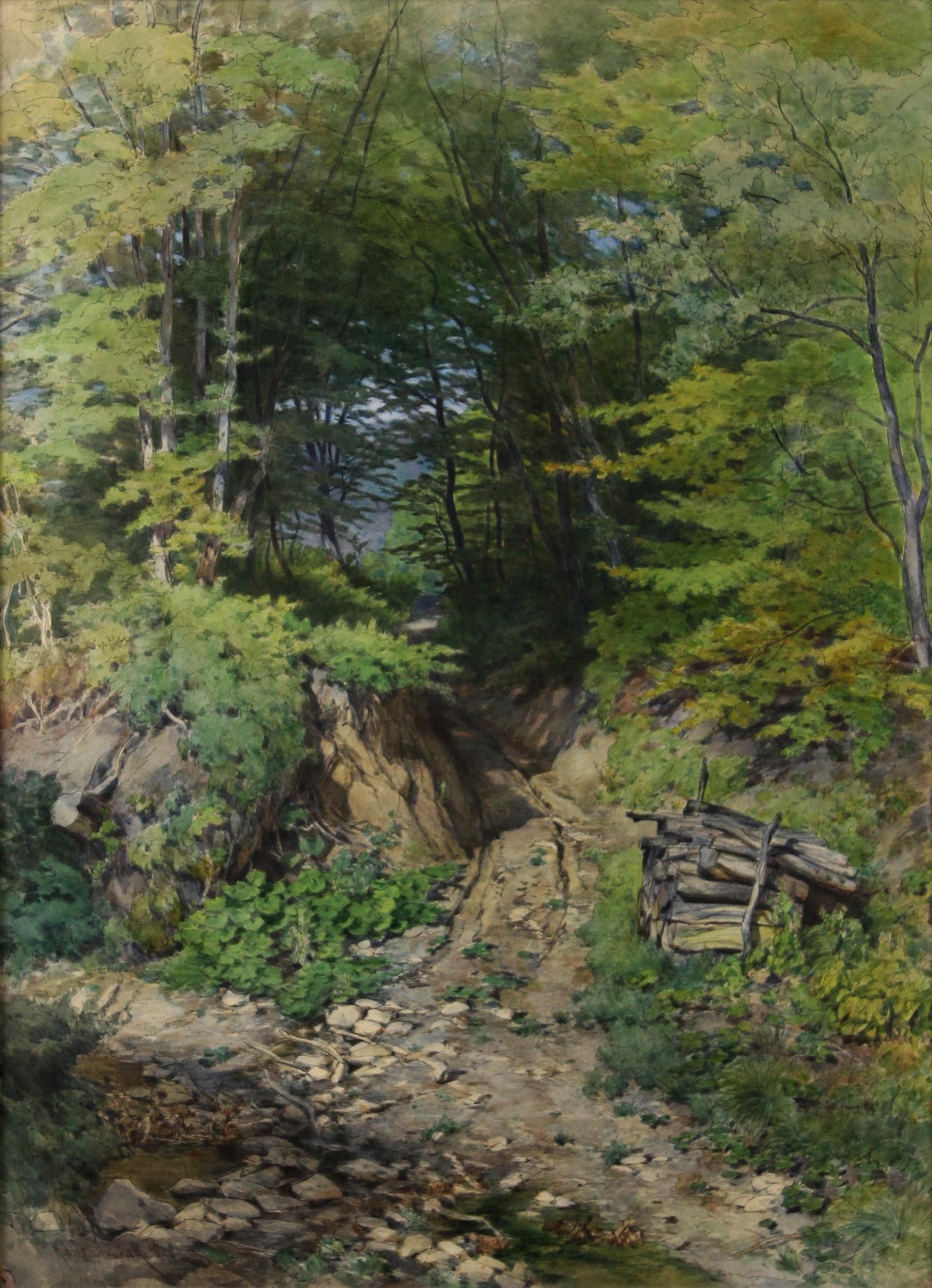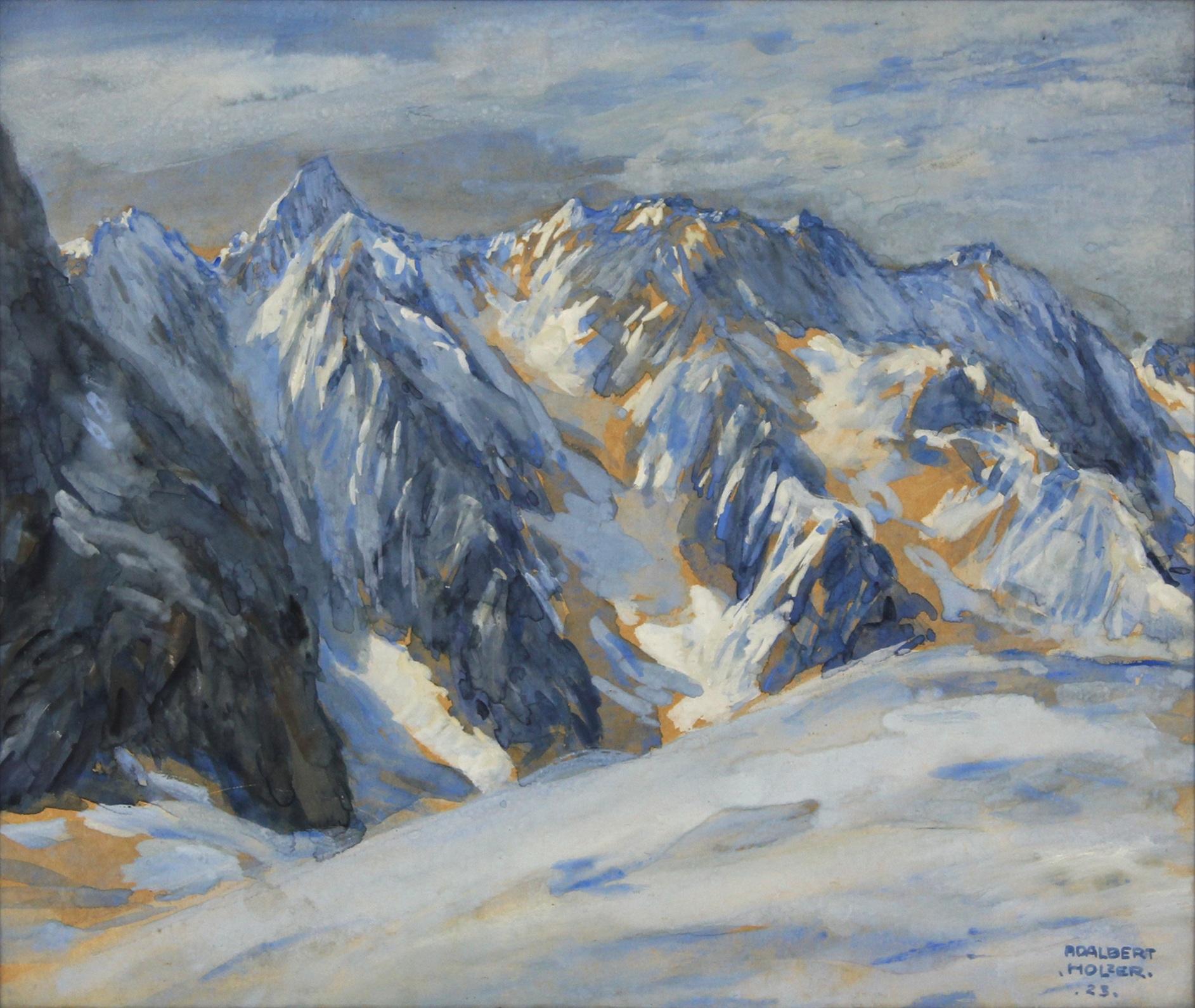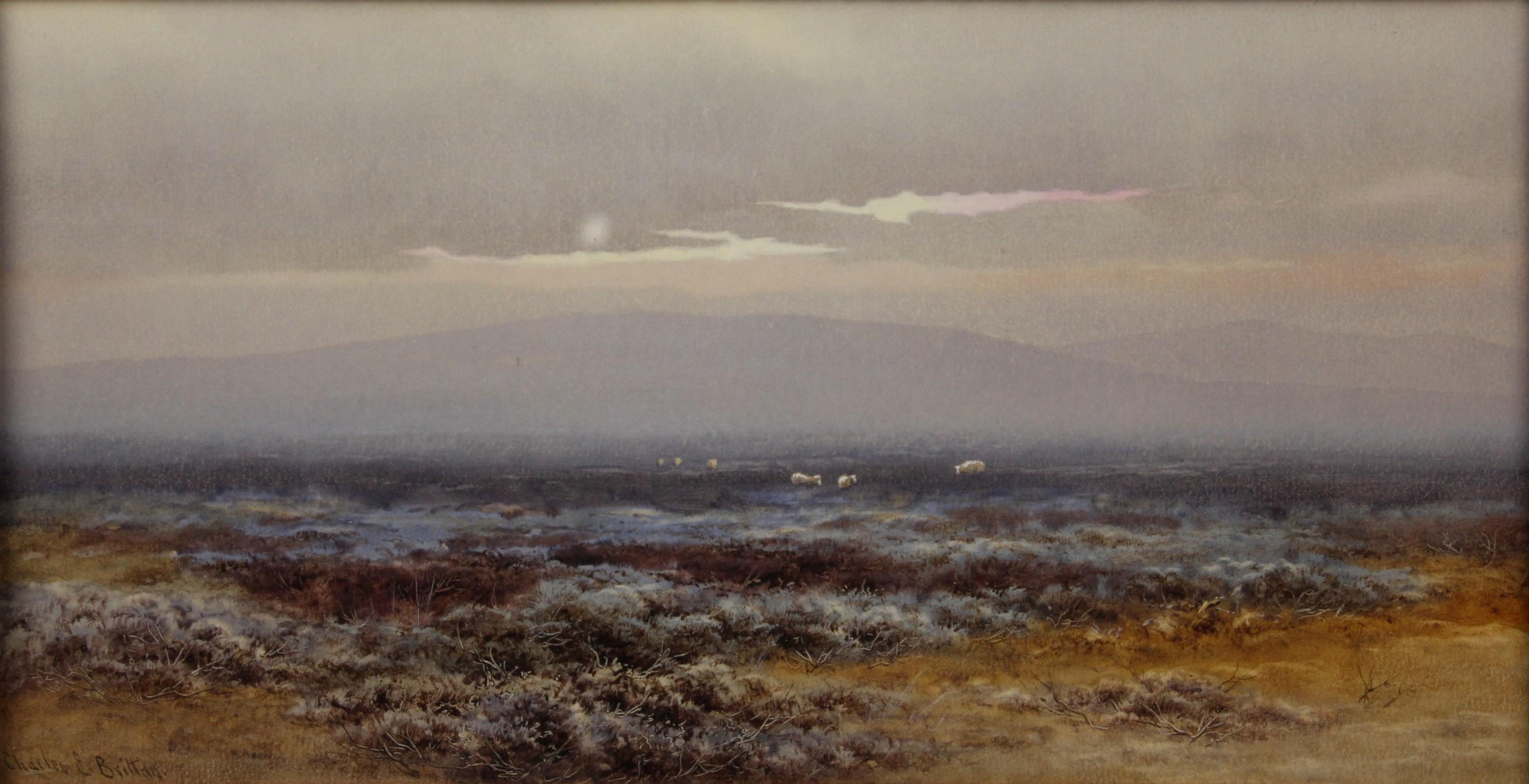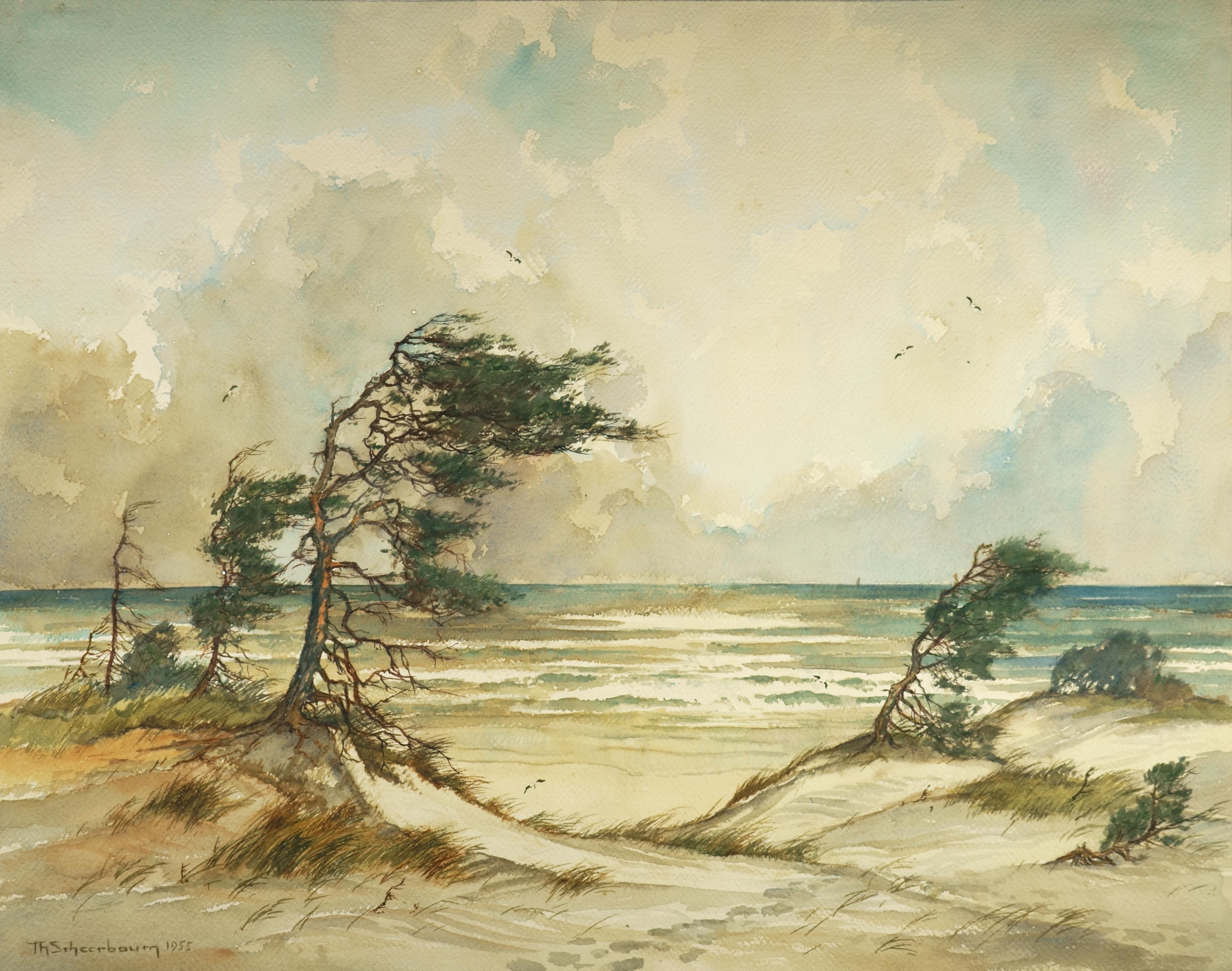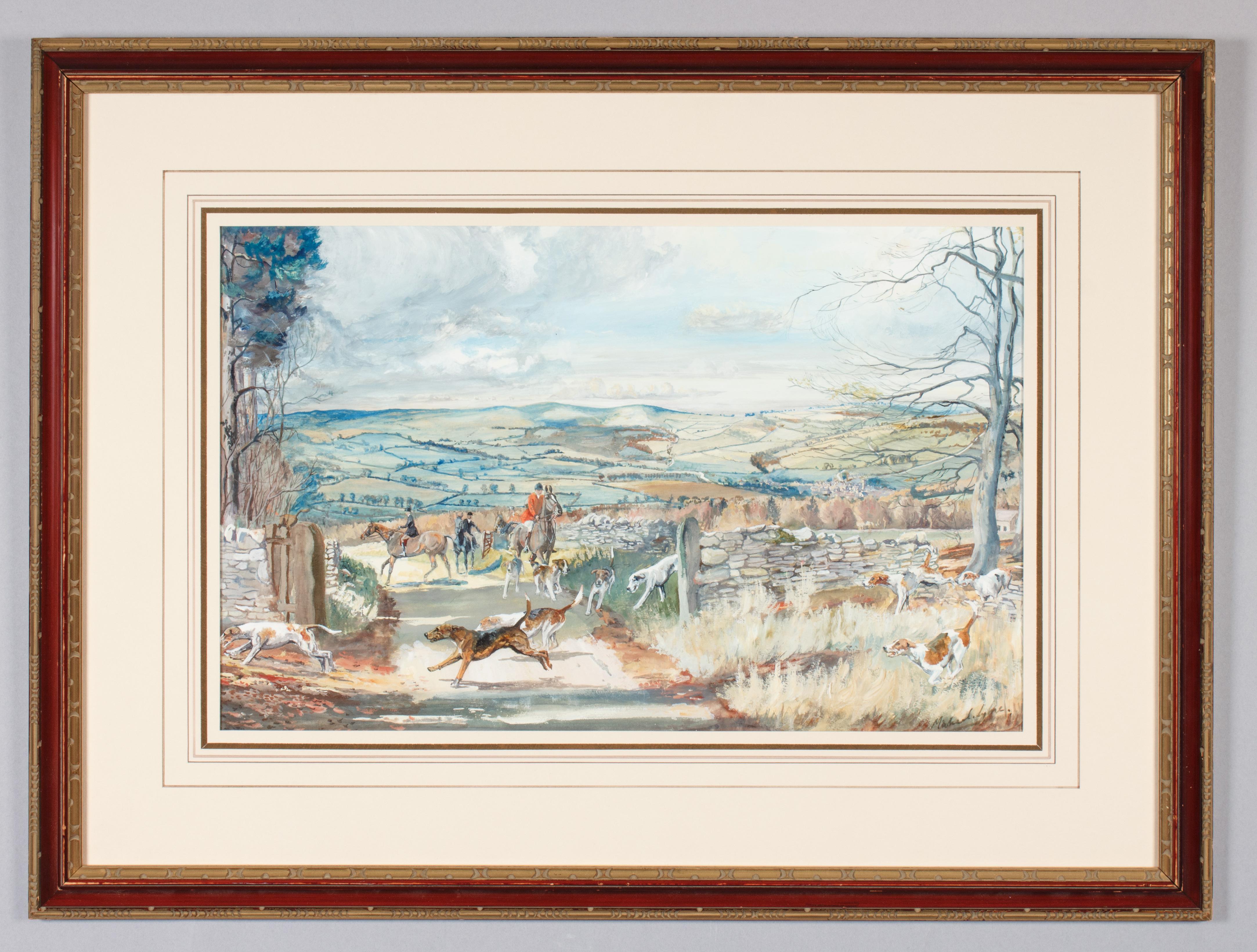Items Similar to 20th Century British Watercolour of Boats at Teddington by Paddy Carstairs
Want more images or videos?
Request additional images or videos from the seller
1 of 5
John Paddy Carstairs20th Century British Watercolour of Boats at Teddington by Paddy Carstairs1952
1952
About the Item
JOHN PADDY CARSTAIRS
(1910-1970)
Boats at Teddington
Signed and dated ‘52; bears title and the artist’s address on the label attached to the backboard
Watercolour and bodycolour over pencil
34 by 48.5 cm., 13 ½ by 19 in.
(frame size 47 by 61 cm., 18 ½ by 24 in.)
Exhibited:
London, The Chelsea Art Society.
John Paddy Carstairs (born John Keys) was a British film director, television director, comic novelist and painter.
He studied at Repton and the Slade School of Fine Art. He exhibited at the Royal Academy, Leicester Galleries, Royal Society of British Artists and Paris Salon and held one man shows at the Redfern Gallery, Leger Gallery and Walkers Galleries. Works by him are in the collections of Trinity College, Oxford, Manchester City Art Gallery and Kirkcaldy Museum and Art Gallery.
As a director he is best known for his long associate with the television and film adaptations of Leslie Charteris’ novels chronicling the adventures of his charming hero Simon Templar, alias “The Saint”. He also directed many British comedies including many of Norman Wisdom’s films.
He lived in Chiswick and later at Kingston Hill, Surrey.
- Creator:John Paddy Carstairs (1910 - 1970)
- Creation Year:1952
- Dimensions:Height: 13.39 in (34 cm)Width: 19.1 in (48.5 cm)
- Medium:
- Movement & Style:
- Period:
- Condition:
- Gallery Location:London, GB
- Reference Number:

About the Seller
4.9
Vetted Seller
These experienced sellers undergo a comprehensive evaluation by our team of in-house experts.
Established in 2004
1stDibs seller since 2018
50 sales on 1stDibs
Typical response time: 15 hours
- ShippingRetrieving quote...Ships From: Banbury, United Kingdom
- Return PolicyA return for this item may be initiated within 14 days of delivery.
More From This SellerView All
- 1970s British watercolour of Rusting Cars by Ian HayLocated in London, GBIAN HAY (Born 1940) Cars Rusting Signed l.r.: Ian Hay; bears title and dated 1973 on exhibition label on the backboard Watercolour and gouache Framed 44 by 88 cm., 17 ¼ by 34 ¾ in...Category
1970s Realist Landscape Drawings and Watercolors
MaterialsWatercolor, Gouache
- Hildenborough, Sevenoaks, Kent - British Watercolour by Adolphe RagonLocated in London, GBADOLPHE RAGON (1847-1924) On the Road from Hildenborough to Sevenoaks, Kent Signed in pencil l.r., inscribed with title l.l. Watercolour over traces of pencil Unframed, in conserva...Category
Late 19th Century Realist Landscape Drawings and Watercolors
MaterialsWatercolor
- William Walcot - 20th Century British watercolour of top of Spanish Steps, RomeBy William Walcot R. E. Hon. R. I. B. A.Located in London, GBWILLIAM WALCOT (1874-1943) Piazza Trinita die Monti, the Spanish Steps, Rome Signed and dated l.r.: W Walcot 1922 Watercolour and bodycolour over traces of pencil Framed 54 by 84...Category
Early 20th Century Realist Landscape Drawings and Watercolors
MaterialsWatercolor
- Jules Lessore - 19th Century Watercolour of the Bridge of Sighs, VeniceLocated in London, GBJULES LESSORE (1849-1892) The Bridge of Sighs, Venice Signed l.r.: Jules Lessore Watercolour Framed 24.5 by 17 cm., 9 ¾ by 6 ¾ in. (frame size 44.5 by 36.5 cm., 17 ½ by 14 ½ in.) Provenance: With Duncan Miller Fine Art, London. Jules Lessore was born in Paris and initially studied under his father, the painter, printmaker and ceramic artist, Emile Lessore...Category
Late 19th Century Realist Landscape Drawings and Watercolors
MaterialsWatercolor
- Jules Lessore - 19th Century watercolour of The Ducal Palace, VeniceLocated in London, GBJULES LESSORE (1849-1892) The Ducal Palace, Venice Signed l.r.: Jules Lessore Watercolour Framed 24.5 by 17 cm., 9 ¾ by 6 ¾ in. (frame size 44.5 by 36.5 cm., 17 ½ by 14 ½ in.) Provenance: With Duncan Miller Fine Art, London. Jules Lessore was born in Paris and initially studied under his father, the painter, printmaker and ceramic artist, Emile Lessore...Category
Late 19th Century Realist Landscape Drawings and Watercolors
MaterialsWatercolor
- War Birds - 1920s British watercolour on silk by George SheringhamBy George SheringhamLocated in London, GBGEORGE SHERINGHAM (1884-1937) The War Birds Signed and inscribed with title on a label on the backboard Watercolour and gold paint on silk, semi circle shape, in artist’s decorated mount Framed 24 by 47.5 cm., 9 ½ by 18 ¾ in. (frame size 46 by 71 cm., 18 by 28 in.) Exhibited: London, Leicester Galleries. Sheringham was born in London and studied at the Slade under Henry Tonks and later in Venice, Brussels, Berlin and Paris where he held his first one-man exhibition in 1905. On his return to London he initially supported himself with poster designs and teaching. His first exhibition of fan designs was held at the Ryder Gallery in 1909 followed by another in the following year. With enthusiastic reviews in Studio he had launched his career as a decorative designer, theatrical designer and illustrator. He illustrated books by Max Beerbohm and Cyrus MacMillan. In 1921 he collaborated with his brother Hugh on a book about fishing, The Book of the Fly Rod. He wrote Drawing in Pen and Pencil (1922), with James Laver, Design in the Theatre (1927) and with Rupert Mason and R Boyd Morrison he edited Robes of Thespis, Costume Designs by Modern Artists (1928). As a decorator, Sheringham designed the music room at 40 Devonshire House...Category
Early 20th Century Realist Landscape Drawings and Watercolors
MaterialsWatercolor
You May Also Like
- Shady hollow way - Into the heart of the forest -By Hans DvoràkLocated in Berlin, DEHans Dvořák (19th century). Shady hollow way in a sunny forest. Watercolour and pen-and-ink drawing, 58.5 x 43 cm (visible size), 70 x 55.5 cm (frame), signed and dated "Hans Dvořák ...Category
1880s Realist Landscape Drawings and Watercolors
MaterialsWatercolor
- Wettersteinkamm - The blue of the mountains -Located in Berlin, DEAdalbert Holzer (1881 Munich - 1966 Munich). Wettersteinkamm. Watercolour, 29 x 34.5 cm (visible size), 37.5 x 43 cm (frame), signed and dated at lower right 'ADALBERT HOLZER [19]23'. Framed behind glass. Frame shows signs of wear. - The blue of the mountains - About the artwork The Wetterstein ridge is revealed to the viewer from a gentle, snow-covered hill. In contrast to conventional depictions of mountains, the painting is composed entirely of shades of blue, which condense into the blue-grey of the rock or fade into the white of the snow. As a complementary colour to the blue, Holzer virtuously activates the ochre ground. The uniform yet exciting polarity of the colours emphasises the massive majesty of the mountains and at the same time underlines the special character of the Wetterstein ridge. Holzer transferred the translucency of glass painting, in which he was originally trained, to watercolour and developed a pictorial language related to the art of Ferdinand Hodler, which earned him the nickname 'Master of Blue' and led to the appreciation of his watercolours in particular. About the artist After an apprenticeship as a stained glass painter at the Kunstgewerbeschule, Adalbert Holzer studied at the Munich Art Academy under Carl von Marr...Category
1920s Realist Landscape Drawings and Watercolors
MaterialsWatercolor
- High Moorland Landscape in the fog - The world as a transcendent phenomenon -Located in Berlin, DECharles Edward Brittan Jr (1870 Plymouth - 1949). High moor landscape in the fog. Gouache, signed at lower left "Charles E. Brittan", 18 x 34.5 cm (passepartout), 45 x 62 cm (frame)....Category
Early 20th Century Realist Landscape Drawings and Watercolors
MaterialsWatercolor
- Raft Landscape in Sweden / - Temporary structures -Located in Berlin, DEOtto Eglau (1917 Berlin - 1988 Kampen), Raft Landscape in Sweden, 1956. Watercolor and ink on paper, 45 x 60 cm, signed in his own hand lower right with "Eglau" and dated "[19]56". - somewhat darkened Exposé as PDF - Temporary structures - About the artwork A wide river landscape stretches out before us, its horizon line running across the upper part of the picture, creating the impression of enormous depth. The depth is further extended by the dark tree trunks, most of which spill into the picture, and at the same time rhythmized by their different positions. This sequence of movements gives the landscape a strong dynamic moment. Indeed, the landscape seems to be "fleeing" from beneath us. To keep the gaze on the foreground alone requires a real visual effort. By looking at the foreground, we have already arrived at the background. Therefore, we cannot speak of pictorial grounds in the classical sense. Rather, we are confronted with a structurally rhythmic continuum of space, the dynamics of which are further accelerated by the cut tree trunks in the foreground and the upright trunks in the background, which function as target marks. Since the narrow strip of sky has the same white tonality as the ice, this area also fits seamlessly into the spatial structure, so that a deserted "structural landscape" unfolds before us. The structure, however, is not - as in the case of Piet Mondrian - completely abstract and thus something that exists independently of itself, removed from the time of natural space. The structures that Otto Eglau discovered in nature remain bound to it, which is why they exhibit a temporality that corresponds to the 'course of things'. Even if they correspond to an architecture of nature brought to representation, the structures are not substantial, but contingent. Artistically uncovered, they present themselves to Eglau at the very moment he captures them. In nature itself, these structures will never be repeated in the same way. Panta rhei - everything flows, even if the flow of time is frozen by his artistic representation and the image, for all its dynamism, radiates calm at the same time. "The structures I put behind things, and the lines that hold my paintings, are signs of transient life. They are random like the trace a wave leaves in the sand, blurred like the border between sea and land, ephemeral like the life of a shell I hold in my hand." - Otto Eglau About the artist After his release from captivity in 1947, Otto Eglau studied at the Hochschule für Bildende Künste in Berlin. He was a student of Oskar Nerlinger, Max Kaus and Wolf Hoffmann. From 1953 he taught free drawing for architects at the Technical University of Berlin. In the years that followed, Eglau undertook numerous study trips that took him to Scandinavia, the Arab world, the Far East and even Macau. During these travels he cultivated the technique of watercolour, which allowed him to work quickly in the open air, while retaining a strong painterly quality. Scholarships enabled Eglau to stay in Japan from 1962 to 1963 and in Naples in 1970. From 1969 to 1976 Eglau was professor of etching at the International Summer Academy of Fine Arts in Salzburg. Between 1983 and 1988 Eglau worked simultaneously in his Berlin studio at Lietzensee, which had its own printing press, and in his studio in Kampen on the island of Sylt. Otto Eglau's work has been shown in more than 100 solo exhibitions worldwide and in more than 120 group exhibitions. "I love the vastness of the island. The mudflats off Kampen are my treasure trove; here I discover new shapes and colors every day. Without Sylt, I would be like a fish without water." - Otto Eglau Selected Bibliography Hanns Theodor Flemming: Otto Eglau. Das graphische Werk, Flensburg 1966. Heinrich Seemann (Einführung): Otto Eglau. Inselskizzen, Hamburg 1982. Heinrich Seemann (Einführung): Otto Eglau. Japan, Nepal, Sylt. Aquarelle. Zeichen und Strukturen. Einführung von Heinrich Seemann, Hamburg 1986. Otto Eglau: Watt-Tagebuch. Ausgewählte Aquarelle aus den Skizzenbüchern Otto Eglaus. Kampen 1996. GERMAN VERSION Otto Eglau (1917 Berlin – 1988 Kampen), Floßlandschaft in Schweden, 1956. Aquarell und Tusche auf Papier, 45 x 60 cm, unten rechts eigenhändig in Blei mit „Eglau“ signiert und mit „[19]56“ datiert. - etwas nachgedunkelt Exposé als PDF - Temporäre Strukturen - zum Werk Vor uns erstreckt sich eine weite Flusslandschaft, deren Horizontline im oberen Bereich des Bildes verläuft, wodurch der Eindruck einer enormen Tiefenerstreckung entsteht. Die Tiefe wird von den dunklen, zumeist ins Bild hineinfluchtenden Baumstämmen zusätzlich geweitet und – durch ihre verschiedenartigen Lagen – dabei zugleich rhythmisiert. Durch diese Bewegungsabfolge weist die Landschaft ein starkes dynamisches Moment auf. Und tatsächlich stellt sich der Eindruck ein, als ob die Landschaft unter uns ‚hinwegfluchten‘ würde. Den Blick einzig im Vordergrund zu halten, verlangt regelrecht eine visuelle Anstrengung. Auf den Vordergrund schauend sind wir bereits im Hintergrund angelangt. Daher kann gar nicht von Bildgründen im klassischen Sinne gesprochen werden. Vielmehr steht hier ein strukturell rhythmisiertes Raumkontinuum vor Augen, dessen Dynamik von den angeschnittenen Baumstämmen vorne und den als Zielmarken fungierenden aufgerichteten Stämmen hinten zusätzlich beschleunigt wird. Da der schmale Himmelstreifen dieselbe Weißtonalität wie die Wasserlandschaft aufweist, fügt sich auch dieser Bereich bruchlos in das Raumgefüge ein, so dass sich vor uns eine menschenleere ‚Strukturlandschaft‘ ausbreitet. Die Struktur ist aber nicht – wie dies bei Piet Mondrian der Fall ist – gänzlich abstrakt und dadurch etwas eigenständig für sich Bestehendes, das der Zeit des Naturraums enthoben ist. Die von Otto Eglau in der Natur entdecken Strukturen bleiben an diese zurückgebunden, weshalb sie eine dem ‚Lauf der Dinge‘ entsprechende Temporalität aufweisen. Auch wenn sie einer zur Darstellung gebrachten Architektur der Natur entsprechen, sind die Strukturen nichts Substanzielles, sondern kontingent. Künstlerisch aufgedeckt, bieten sie sich Eglau in eben jenem Moment dar, den er festhält. In der Natur selbst werden diese Strukturen niemals in derselben Art wiederkehren. Panta rhei – alles fließt, auch wenn sich der Fluss der Zeit durch seine künstlerische Darstellung verfestigt hat, wodurch das Bild – trotz aller Dynamik – zugleich auch Ruhe ausstrahlt. „Die Strukturen, die ich hinter die Dinge setze, und die Linien, die meine Bilder halten, sind Zeichen des vergänglichen Lebens. Sie sind zufällig wie die Spur, die eine Welle im Sand hinterlässt, unscharf wie die Grenze zwischen Meer und Land, vergänglich wie das Leben einer Muschel, die ich in der Hand halte.“ - Otto Eglau zum Künstler Nach seiner Entlassung aus der Kriegsgefangenschaft 1947 nahm Otto Eglau ein Studium an der Hochschule für Bildende Künste in Berlin auf. Dort war wer Schüler von Oskar Nerlinger, Max Kaus und Wolf Hoffmann. Ab 1953 unterrichtete er freies Zeichnen für Architekten an der Technischen Universität Berlin. In den Folgejahren unternahm Eglau zahlreiche Studienreisen, die ihn nach Skandinavien, in den arabischen Raum, nach Fernost und bis nach Macau führten. Auf diesen Fahrten kultivierte er die Technik des Aquarellierens, die eine zügige Bildschöpfung im Freiraum erlaubt und dennoch eine stark malerische Qualität aufweist. Stipendien ermöglichten es Eglau, sich von 1962 bis 1963 in Japan aufzuhalten und 1970 länger in Neapel zu verweilen. Von 1969 bis 1976 hatte Eglau die Professur für Radierung an der Internationalen Sommerakademie für Bildende Kunst in Salzburg inne. Zwischen 1983 und 1988 war Eglau parallel in seinem Berliner Atelier am...Category
1950s Realist Landscape Drawings and Watercolors
MaterialsWatercolor
- Wind Dodgers at the Baltic SeaLocated in Berlin, DETheodor Scheerbaum (1897 Reichenbach im Vogtland), Wind Dodgers at the Baltic Sea. Watercolor on strong yellowish grained paper, 44 x 56 cm, signed by hand "Th[eodor] Scheerbaum" at ...Category
1950s Realist Landscape Drawings and Watercolors
MaterialsWatercolor
- North Cotswold Hounds on Sudeley Hill: a watercolor by Michael LyneBy Michael LyneLocated in Philadelphia, PAMichael Lyne (English, 1912-1989) North Cotswold Hounds on Sudeley Hill, 1934 Gouache on paper, 11 3/4 x 18 1/2 inches Signed and dated at lower right: "Michael Lyne/34" Inscribed in...Category
1930s Realist Landscape Drawings and Watercolors
MaterialsPaper, Watercolor
